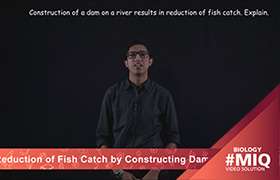CBSE Class 10 Answered
Please answer
Asked by Abhijeetoo7 | 27 Feb, 2010, 11:26: PM
This is due to the following reasons:
- Dams act as physical barriers to migranting fish, preventing their passage to the usual breeding, rearing, and feeding grounds. This results in massive failure of recruitment, and eventual extinction of the species. Undesirable species may then start filling up such blank areas.
- Blocking results in change in physico-chemical and biological parameters upstream and downstream as well as in surrounding environment and also causes fluctuations in plank tonic, crustacean and molluscan fauna which are the natural fish food.
- Fish passing downstream through structures at a dam can suffer mortality or damage in a number of ways including abrasion against rough surfaces, turbine blade mangling, rapid pressure changes, water shearing effects and nitrogen super saturation in the stilling basin.
- During warm season the reservoir get thermally stratified which can result in deoxygenation of the hypolimnion. Cool and\or anoxic water discharged from the hypolimnion can severely reduce water quality downstream and negatively impact fish stock and fisheries.
- The sediment released from the reservoir can hasten turbidity which can create severe problems for the downstream flora and fauna.
- Sediments trapped in the reservoir may be contaminated with pesticides and other chemicals from catchments sources, which may enter the reservoir food chain and make fish poisonous.
- In most cases, blocking the rivers by damming results in change in fish biodiversity and stock abundance. Usually the number of fish species decline. Stocks of long distance migrating fish species and fast flowing water species decline while stocks of pelagic species and species that prefer slow moving water increase.
- The clearing or no clearing of trees from submergence can cause important consequences for fish production. Although drowned trees increase the food supply for fish, however trees also readily entangle fishing gears, thus decreasing the catch ability of fish.
- Extensive deoxygenation and acidification may occur due to rotting of submerged vegetation which may result in the extensive kill of the original riverine population in the lower layers of water.
Answered by | 01 Mar, 2010, 06:43: AM
Application Videos
Concept Videos
CBSE 10 - Biology
Asked by kanikathakur1476 | 26 Mar, 2021, 08:29: PM
CBSE 10 - Biology
Asked by sangeet | 10 Sep, 2020, 06:58: PM
CBSE 10 - Biology
Asked by manyavalecha30 | 19 Apr, 2020, 06:01: PM
CBSE 10 - Biology
Asked by sleepingdox | 29 Mar, 2020, 11:58: AM
CBSE 10 - Biology
Asked by officialmehak26 | 06 Feb, 2020, 09:12: PM
CBSE 10 - Biology
Asked by subbukum | 04 Feb, 2020, 10:22: AM
CBSE 10 - Biology
Asked by sukumarpatra3968 | 26 Nov, 2019, 06:58: PM
CBSE 10 - Biology
Asked by poonampandit087 | 09 Nov, 2019, 07:58: AM
CBSE 10 - Biology
Asked by vedantsagrawal23 | 18 Aug, 2019, 01:39: PM
CBSE 10 - Biology
Asked by minjingchemshy | 17 May, 2019, 11:18: AM












